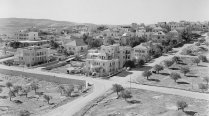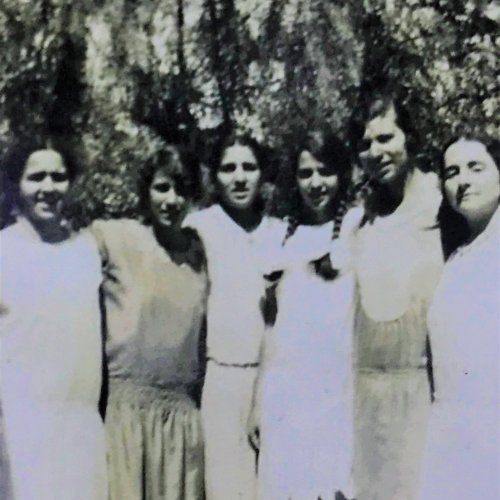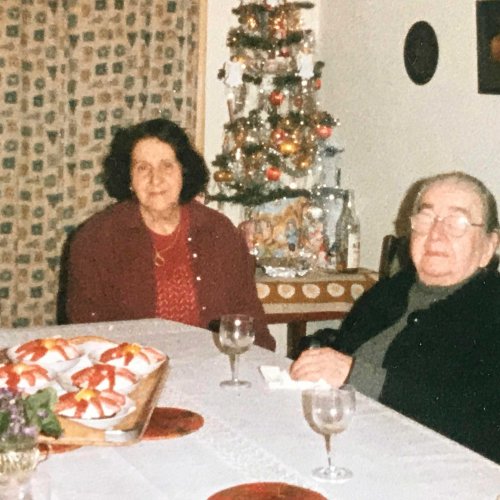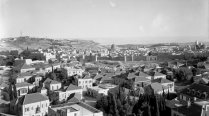Sophie Halaby (b. June 26, 1906, in Jerusalem or Kiev) was a professional Palestinian watercolor artist whose life spanned most of the 20th century. Her primary subject matter was the landscape of Jerusalem, unscarred by foreign occupation and urban development. As the first Arab woman to travel to Paris in the 1920s to study art, Halaby inspired generations of younger Palestinian women to pursue their passion. In addition to being a role model, Halaby was a professional artist whose pieces were consistently of high quality, earning her an enduring reputation as one of Palestine’s most talented and accomplished artists.
Family Background
Three sources provide details about the life of Sophie Halaby; unfortunately, they differ on key details about her early years. She was the daughter of Jiryes Nicola Halaby and Olga Akimovna Khudobasheva. Her father had gone to Russia for higher education; he either met and married Olga in Russia and took her to Palestine or, upon his return, he met Olga, who was teaching in a Russian school in Palestine, and they married. Sophie Halaby was born in Jerusalem (or possibly Kiev) on June 26, 1905, or 1906; she had a brother, Nicola, three years her senior, and a sister, Anastasia (Asia), three years younger.1
The Halaby family lived in the upscale Palestinian neighborhood of Musrara, in Jerusalem’s New City, and remained there until 1948. The family was well-off and owned considerable property. Halaby spoke four languages and grew up in Jerusalem with 14 paternal cousins nearby. The icon painter and muralist Khalil Halaby (teacher of Palestinian artist Kamal Boullata) was a distant relative.
The family left Jerusalem when World War I broke out, as they were closely connected with the Russian Orthodox Church—Olga was a Russian national—at a time when the Russian and Ottoman empires were at war. They lived in Kiev for a while. When the Bolshevik Revolution swept the country in 1917, they returned to Jerusalem later that year.
Halaby identified with her mother’s culture and often spoke Russian to her sister for private communication. She maintained a connection with the Orthodox Church throughout her life.
Education
Halaby attended and graduated from the Jerusalem Girls’ College in the Rehavia neighborhood of Jerusalem’s New City. In her art classes, she was told to draw flowers, and her talent soon became apparent to her teachers and classmates. Throughout her career, in fact, she never stopped drawing flowers.
After completing school, she worked for the British Mandate administration in Jerusalem. She soon learned that employees were not treated equally; Palestinian staff were generally paid less than Europeans and quickly hit a glass ceiling. Four years later, she applied for and received a scholarship to study art in Paris. That she could do so in Palestine in the late 1920s says a great deal about Palestinian middle and upper classes and about the cosmopolitan social environment of 1920s Jerusalem.
An Artist Is Born
Between 1929/30 and 1933, Halaby lived in an international student hostel in Paris, studied in a few private studios, and visited art galleries and museums. She also submitted works to exhibitions and won at least one prize. Some of her paintings suggest that she might have made a side trip to Italy before leaving Europe.
She returned to Jerusalem in 1933 and identified herself thereafter as a professional artist; she painted postcards and ordered painting supplies from Paris. She began teaching art at the Schmidt Girls’ School in Jerusalem, where she remained until 1955, after which she retired from teaching and devoted herself full-time to her art.
Halaby avoided exhibiting her work alongside political and nationalist artists. But in 1936, during the tense early days of the Great Palestinian Revolt, she contributed eight political cartoons to the new weekly English-language publication Palestine and Transjordan. The cartoons were critical of British Mandate policies, which permitted massive Jewish immigration to Palestine, and reflected her opposition to Zionism.
The Nakba and the Naksa
Like many Palestinian families living in what would become West Jerusalem, in the spring of 1948, the Halaby family had to leave their home in the New City neighborhood of Musrara to escape the threat of Zionist terrorist gangs. Two months before she left her home with her mother, Halaby packed up her paintings and stored them in a safe place; Schor speculates that she probably sought the assistance of either British officials or Russian clergy in doing so. In April 1948, Halaby and her mother took refuge in a Russian Orthodox convent in the Old City—her father had died in 1945 and her brother had left Palestine for Lebanon. In the second half of 1949, she went to Paris for several weeks of art study, stopping in Italy before returning to Jerusalem.2
Halaby, her mother, and her sister, Asia, eventually settled in the neighborhood of Wadi al-Joz in what became East Jerusalem, in a home built by Halaby’s brother, Nicola, who was an architect. His design included a third-floor studio for his sister. It would become her sanctuary, off limits to visitors, unless she trusted them. Their mother lived in it for only a few years; she died in 1952. The sisters would live together in this home for much of their lives.3 They were well-off, thanks to their inheritance of property, and they enjoyed an active social life that included evenings at the American Colony Hotel, consular events, and travel abroad.
In 1960 or so, Halaby and her sister publicly severed relations with their brother because they did not approve of his marriage. This family drama would unfortunately expose the sisters to tricksters who would swindle them out of their fortunes.
Less than 20 years after the war of 1948 (the Nakba) drove them from Musrara, another war disrupted their lives. During the war of 1967 (the Naksa), which resulted in Israel’s occupation of East Jerusalem, Halaby’s studio was destroyed by Israeli shelling. She was profoundly shaken by the destruction of her studio, which she clearly regarded as more than just a workspace.
People who knew the sisters recounted a story that took place during the 1967 War, when two Jordanian soldiers sought refuge in the Halaby home. The sisters got men’s clothing from the neighbors so that the soldiers could get out of their uniforms and get back to their homes without being picked up by the Israelis as enemy combatants. Later, the sisters had to dispose of the uniforms, which they did gradually, so as not to arouse suspicion.4
Just over a year after the war, Halaby’s distress following the occupation of East Jerusalem was captured in a letter she wrote to friends who had emigrated: “We still think it is a bad dream. The maddening, sickening happenings around us cannot—and should not—be a reality. We were ‘liberated’ now everything is done to ‘integrate’ us and [to] facilitate their process ‘laws’ are being passed.”5 Bulldozers (“modern machinery of destruction”6) worked around the clock. Hilltops were flattened and rows of prefabricated houses were placed on them, including in her beloved Musrara; with the occupation of East Jerusalem in 1967, Israeli developers bulldozed the Halaby’s homes in Musrara to build a park and an office complex.7
In her last years, Halaby recounted to an interviewer the difficulty of being unable to see family members who were denied entry to the country by the Israeli authorities.8
Halaby the Artist
Halaby displayed works in the window of the basement workshop where Asia sold embroidery. The shop received a lot of customers. The artwork was changed once a week, and budding artists like Kamal Boullata made a point of passing by the shop periodically to see Halaby’s latest work. Years later he recalled feeling inspired by her work and by her presence as a working artist living in politically difficult times.9
She had several exhibits in Jerusalem’s YWCA. In 1986, she was the featured guest in the “Tallat: Women’s Art in Palestine” exhibition, which took place in the Hakawati Theatre, in the Sheikh Jarrah neighborhood of Jerusalem. It showcased the work of 10 women artists from the occupied Palestinian territories. Halaby contributed three works to the exhibition: two landscapes and a charcoal drawing.
As for the quality of Halaby’s art, we rely on the assessments of artists who could discern what she was trying to do and how closely she realized her vision. Despite the occasional oil painting, Halaby’s preferred medium was watercolors. Her subject matters were landscape, particularly the hills around Jerusalem, still lifes (mostly flowers in vases, occasionally fruit), and human figures.
Artist Samia Halaby, a distant relative of Sophie Halaby, credits her with “creating illusions of space,” and knowing “when to stop, when not to indulge in refining details, a truly rare quality, a quality particularly necessary to the rigorous discipline of watercolor painting.”10 Samia Halaby describes currents in Arab and European art history and places Sophie Halaby squarely in the transitional space at a time of great change, from “dormant feudalist relations” to the modernist trends in the late 20th century.11
Palestinian artist Kamal Boullata viewed her focus on landscapes and still life as complementary: Her landscapes captured not what she saw as much as what she remembered. She frequently complained about the construction scarring her surroundings, but none of that ugliness found its way to her work. Her still lifes of flowers preserved the fleeting freshness of the petals.
Halaby Remembered by the People Who Knew Her
Halaby biographers Laura Schor and Samia Halaby conducted extensive interviews with people who knew the artist, and they provide anecdotes that give us a sense of her personality. We learn, for example, that she was an artist who took her work seriously. When she met Samia Halaby, who shares her initials, she quickly instructed her how to sign her work, so that their work could never be confused (even though their very different styles made that unlikely).
She liked playing on words by changing a single letter in a word to convey an attitude. For example, she would refer to the dish musakhan as musakham, or unfortunate, which amused her listener. She sewed her own clothes. She had strong political opinions. She was outspoken and could be blunt. She generously gave paintings away to those who admired them but charged them for the paint. She had a good sense of humor and liked to play harmless pranks on others. She was an elegant hostess. She and her sister were famous for feeding cats and claimed to have taught a favorite cat to eat at the table using a fork. She was devoted to her sister; the two traveled a lot. She made postcards of some of her paintings and gave them away. Formal religion was not a big part of her life, although she maintained a connection with the Russian Orthodox Church. She reportedly did not write to friends and relatives in other countries because she could not bring herself to buy Israeli stamps.
Legal Battles
Halaby had a running legal battle with Mayor Elias Freij of Bethlehem, whom she accused of cheating her. She signed over property with the understanding that the municipality would use it to build a community facility, but later found that he had transferred it to his name.12 She claimed that he organized a campaign to pressure her to drop her lawsuit against him. She also complained about former Jerusalem mayor Teddy Kollek, who was in office when her family home in Musrara was demolished.
She retained a lawyer, Issa Hamed, to secure property holdings, and he seems to have dealt her the final blow, swindling the sisters out of their title to the home and its contents. Hamed and his family moved into the Halaby home, and friends who tried to visit Halaby reported that he isolated her, denying them access to her.
Death and Legacy
Halaby died in hospital on May 22, 1997 and was buried on the Mount of Olives; Asia died nine months later. Hamed inherited a fortune from the sisters and spent much of it wastefully; he did not even bother to place proper headstones on their graves. He died a few years after the sisters. Members of the Halaby family were still trying to regain control of their family property 20 years later.
After Halaby’s death, her personal and professional papers disappeared. Some of her paintings were tossed in the trash, but a local youth found them and informed Mazen Qupty, an art collector. Recognizing the value of Halaby’s work, Qupty and George al-Ama, another art collector, collected and stored as many of her works as they could locate.
In the words of Kamal Boullata, an authority on Palestinian art history, Halaby “never ceased striving to capture in her painting what has been eternally beautiful in the city of her forefathers.”13 In a sense, this was her private act of resistance.
Sources
Ari, Nia. “Speaking in a Different Key: The Life and Art of Sophie Halaby.” Jerusalem Quarterly, no. 81 (Spring 2020): 155–63.
Boullata, Kamal. Palestinian Art: From 1850 to the Present. Preface by John Berger. London: Saqi Books, 2009.
Halaby, Samia. “Sophie Halaby, Palestinian Artist of the Twentieth Century.” Jerusalem Quarterly, no. 61 (Winter 2015): 84–100.
Schor, Laura S. Sophie Halaby in Jerusalem: An Artist’s Life. Syracuse: Syracuse University Press, 2019.
“Sophie Halaby in Jerusalem: An Artist’s Life.” Washington Report on Middle East Affairs. YouTube, October 17, 2019.
Vater, Sabeth. “Laura S. Schor’s New Biography: Sophie Halaby in Jerusalem: An Artist’s Life.” Palestine-Israel Journal [blog]. February 4, 2020.
Notes
This essay draws on the work of Halaby’s biographer, Laura Schor, and two biographical sketches by Palestinian artists Kamal Boullata and Samia Halaby (a distant relative). Laura S. Schor, Sophie Halaby in Jerusalem: An Artist’s Life (Syracuse: Syracuse University Press, 2019); Kamal Boullata, Palestinian Art: From 1850 to the Present, preface by John Berger (London: Saqi Books, 2009); and Samia Halaby, “Sophie Halaby, Palestinian Artist of the Twentieth Century,” Jerusalem Quarterly, no. 61 (Winter 2015): 84–100.
Schor, Sophie Halaby in Jerusalem, 104, 113.
Asia developed dementia and was placed in a nursing home toward the end of her life. Olga’s date of death is another detail on which the biographers disagree: according to Schor she died in 1952, whereas Samia Halaby places that event sometime in the 1960s.
Schor, Sofie Halaby in Jerusalem, 155; Halaby, “Sophie Halaby,” 88.
Schor, Sofie Halaby in Jerusalem, 170.
Schor, Sofie Halaby in Jerusalem, 170.
Schor, Sofie Halaby in Jerusalem, 185.
Halaby, “Sophie Halaby,” 97.
Kamal Boullata, “Foreword,” in Schor, Sophie Halaby in Jerusalem, xii.
Halaby, “Sophie Halaby,” 91.
Halaby, “Sophie Halaby,” 95.
Schor, Sophie Halaby in Jerusalem, 185.
Boullata, “Foreword,” xiii.




